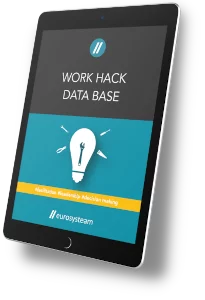This method clarifies whether all participants are mentally present at the beginning of a workshop, brings workshops to a dignified end and improves the team culture.
(Deutsche Version unten)
Description
Many people stumble from one meeting to the next or, for other, very individual reasons, are often unable to fully engage with a new constellation of interlocutors. Or a group of people has not seen each other for a long time and first has to “warm up” to each other again. Here a short check-in round helps. The effect is multi-part: I have to ask myself what is going on with me right now, whether I am completely there or not. That alone helps immensely. In speaking it out, it is acknowledged by me and others and can be considered. Moods are not secretly dragged into a meeting. In the round of workshop participants, a feeling for each other and a mindfulness for the group emerges that lasts later in the meeting.
Procedure
Below are several alternative ways to do a check-in round. Teams should experiment with these and ideally even develop their own appropriate way of doing them.
Option 1) At the beginning of a meeting, participants briefly describe how they are doing generally in the last few days, how they are doing today, and/or how they are feeling since they entered the meeting room. This helps participants be in the moment and raise their awareness for the meeting.
Option 2) The meeting starts with a round where everyone who feels like it briefly tells what positive experience they recently had, what made them happy, who they have recently congratulated or thanked. This creates a positive mood of gratitude, appreciation and trust.
Option 3) Each participant receives 10 paper clips (or alternative objects) with the help of which they should individually represent their attention. The 10 paper clips represent 100%. Everyone now asks themselves “With how many paper clips am I here today? Where are the rest of my thoughts tied?”. It is perfectly fine if not all 10 are there, as this is more about becoming aware of which topics are tying up one’s attention.
Check-out:
At the end of the meeting, participants can once again express their mood. This ritual closes the arc that was started with the check-in and prevents the meeting from fraying at the end and not being closed properly. It also promotes a culture of open exchange and increases the willingness to give each other feedback. The team should be careful that no one misuses the check-out round for further substantive input.
Guiding questions for the check-out round can be:
- How do I feel differently after the meeting than before?
- What did the meeting trigger in me?
- What do I think we did well this time?
Diese Methode klärt, ob am Anfang eines Workshops alle Beteiligten auch geistig anwesend sind, bringt Workshops zu einem würdigen Ende und verbessert die Team-Kultur.
Beschreibung
Viele Menschen stolpern von einem Meeting ins nächste oder sind aus anderen, sehr individuellen Gründen oft nicht in der Lage, sich vollkommen auf eine neue Konstellation von Gesprächspartnern einzulassen. Oder aber eine Gruppe von Menschen hat sich lange nicht gesehen und muss erst wieder miteinander “warm werden”. Hier hilft eine kurze Check-in-Runde. Die Wirkung ist mehrteilig: Ich selbst muss mich fragen, was mit mir gerade los ist, ob ich ganz da bin oder nicht. Das allein hilft ungemein. In dem ich es ausspreche, ist es von mir und anderen anerkannt und kann berücksichtigt werden. Stimmungen werden nicht heimlich in ein Meeting geschleppt. In der Runde von Workshop-Teilnehmenden entsteht ein Gefühl für die jeweils anderen und eine Achtsamkeit für die Gruppe, die auch später im Meeting noch anhält.
Vorgehensweise
Nachfolgend sind mehrere alternative Spielarten einer Check-in-Runde dargestellt. Teams sollten mit diesen experimentieren und idealerweise sogar ihre eigene passende Spielart entwickeln.
Option 1) Zu Beginn des Meetings beschreiben die Teilnehmenden kurz, wie es ihnen zur Zeit generell geht, wie es Ihnen am heutigen Tag geht und/oder wie es ihnen geht, seit sie den Meeting-Raum betreten haben. Dies hilft den Teilnehmenden im Moment zu sein und ihr Bewusstsein für das Meeting zu schärfen.
Option 2) Das Meeting startet mit einer Runde in der alle, die Lust haben kurz erzählen, was sie kürzlich positives erlebt haben, wem sie kürzlich gratuliert oder gedankt haben. Somit entsteht eine positive Stimmung von Dankbarkeit, Anerkennung und Vertrauen.
Option 3) Jeder Teilnehmende erhält 10 Büroklammern (oder alternative Gegenstände) mit Hilfe derer er individuell seine Aufmerksamkeit darstellen soll. Dabei repräsentieren die 10 Büroklammern 100%. Jeder fragt sich nun „Mit wie vielen Büroklammern bin ich gerade hier? Wo sind meine restlichen Gedanken gebunden?“. Dabei ist es völlig in Ordnung, wenn nicht alle 10 da sind, da es hierbei vielmehr darum geht sich bewusst zu machen, welche Themen die eigene Aufmerksamkeit binden.
Check-out:
Am Ende des Meetings können die Teilnehmenden noch einmal ihre Stimmung ausdrücken. Dieses Ritual schließt den Spannungsbogen, der mit dem Check-In begonnen wurde und verhindert, dass das Meeting am Ende ausfranst und nicht ordentlich geschlossen wird. Es fördert ausserdem eine Kultur des offenen Austauschs und erhöht die Bereitschaft, sich gegenseitig Feedback zu geben. Das Team sollte darauf achten, dass niemand die Check-Out-Runde missbraucht für weitere inhaltliche Einlassungen.
Leitfragen für die Check-Out-Runde können sein:
- Inwiefern geht es mir nach dem Meeting anders als vorher?
- Was hat das Meeting bei mir ausgelöst?
- Was ist uns meiner Meinung nach diesmal gut gelungen?



